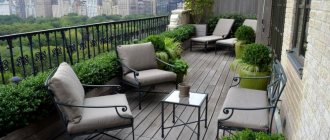Landscaping and plants
05/14/201607/11/2016 balkoninfoLeave a reply
It has long been known that plants have a calming and relaxing effect, and they also saturate the room with pure oxygen. They charge you with energy in the morning and give you a good mood. Lucky are those who have a balcony. After all, you can organize a home garden on it and enjoy the beauty of plants even in winter. But how to do this? Let's take a closer look at how to do landscaping on a balcony with your own hands.
The benefits of creating a green corner
Plants bring joy, help relax the eyes and saturate the air with oxygen. True, in urban conditions it is almost impossible to appreciate all the delights of nature. After a hard day at work, you want to find yourself in a cozy, as comfortable environment as possible. Greens help create it.
You can simply place flowerpots on the balcony to create the right atmosphere. True, you can approach the matter in a more extraordinary way. On the loggia you will be able to grow a whole garden that will constantly please the eye. It is even appropriate to grow greens, which can later be added to various dishes.
What to grow in an indoor lawn
Since the lawn will be placed in the room, it will not get as much sun. At least less than on the street. A group of shade-tolerant herbs is just for such a case. The seed packets indicate the location of the lawn (in the shade or in the sun). Mixtures often include fescue, ryegrass, thin bentgrass, white bentgrass, etc.
Very nice lawns are made from ophiopogon. This herbaceous evergreen plant grows quickly, forming low ornamental bushes that do not even require cutting.
Sowing is done as on a regular lawn - the seeds are scattered as evenly as possible on the soil surface, after which they are raked with a small rake or sprinkled with a 1-1.5 cm layer of soil.
If very little sun gets into the room, it is better to organize a home lawn with the help of ground covers that grow into green “mats”: ivy, fittonia, selaginella, nertera, etc.
Gardening methods
There are several methods of landscaping. The following can be used on the balcony:
- Horizontal. An excellent solution for spacious loggias. When using this method, plants are placed around the entire perimeter of the room. All kinds of racks, shelves and stands are used. You can also install a strip along the entire length of the window opening. It is perfect for placing all kinds of plants.
- Vertical. The emphasis is on one wall. Preference is given to climbing and climbing plants. As a rule, this method is used by owners of small balconies who want to save maximum space. The plants are placed on supports or stands so that their vines go down.
- Combined. In this case, horizontal and vertical landscaping is combined. At the same time, it is possible to create a truly exquisite design and significantly transform the room.
Whatever method is chosen, the result of your efforts will certainly please you. With the help of plants, the balcony will become cozy and you can spend time with pleasure in this area.
Azarina
Azarina, or Murandia, is an attractive flowering perennial native to Mexico and also grows in the southern United States. Currently, the liana is very popular among flower growers and garden designers.
The plant has highly branching shoots up to 7 meters long, which cling to the support with thin twisting petioles. Azarina leaves are small, round in shape, with jagged edges and a velvety surface. The flowers are single, large, located along the shoot to the very top. The color of the inflorescences is varied: white, violet, yellow, purple.
Some hybrid varieties are distinguished by two-color petals.
Azarina is a moisture-loving plant, so it requires plenty of watering. To prolong the flowering period, during the dry period the vine can be sprayed with warm water. Care includes mandatory loosening of the soil near the roots and regular weeding.
Selecting Suitable Plants
When landscaping a loggia, various plants can be used. In this case, you should consider the best options.
Perennial and annual vines
These plants are extremely popular. With their help, the wall on the balcony is significantly transformed. In addition, vines create shade and save from the sweltering heat. Most often, when landscaping a loggia, the following varieties are used:
- morning glory. An annual vine that grows quickly and is unpretentious. Its distinctive feature is the presence of multi-colored bright flowers, which reach 5 cm in diameter. Morning glory is grown in a well-lit area with loose, nutritious soil with drainage. It sprouts from seeds and grows up to 5 m during the summer. When the temperature drops, the vine dies;
- thunbergia. It is also an annual, reaching 2 m in length. The flowers of the vine are orange, yellow and snow-white. Their diameter is 5 cm. The core of the flowers is dark;
- nasturtium. Another annual that pleases the eye with rich colors. It has not only decorative, but also nutritional value. Young flowers and leaves contain large amounts of ascorbic acid. They are often added to summer salads. The vine also bears fruit. They are also suitable for eating.
Perennial vines can also be grown on the balcony. For example, you can plant lemongrass or clematis.
Houseplants
Using indoor plants you can create vertical gardening. Flowerpots with them are placed in tiers along one of the walls. It is recommended to choose original decorative flower pots for them that will help create a special look.
The tandem of vines and plants planted in pots will look interesting. When using such a composition, the loggia acquires an incredibly beautiful appearance.
Selection of furniture and decor for the winter garden on the balcony
Good, high-quality and beautiful furniture, although it does not affect the development of ornamental plants, fully participates in the interior of the balcony.
Full range of garden furniture → in the DG Home catalog. Here you will find wicker, wooden and upholstered furniture to suit different interior styles.
Rattan wicker chairs have confidently moved into modern apartments
Furniture for the loggia should be compact and light - it will have to be moved periodically. From stationary elements, you can choose wooden seats with storage drawers. If your balcony can withstand heavy loads (up to 200-300 kg), rocking chairs, sun loungers, and chests of drawers are suitable.
Solid furniture is suitable for reinforced balcony slabs
Comfortable chairs will add coziness
Wicker furniture will become a bright, functional decor of the winter garden
Do you like the vertical layout? Put up a shelving unit.
And in Provence, and in rustic, and in modern classics
Plants themselves can become living decor - just hide unsightly decoration behind them
Suitable Products
No inventory boxes? This is also not a problem - in the Provence style, various watering cans and bottles will become decorative elements.
Old dishes in the garden are turned into useful items
Watering cans, pots, gnomes, flowers - sometimes you don’t even have to spend money on creating an atmospheric interior
In order not to overdo it with colors, choose a calm color scheme for decoration. Blooming buds will take attention to themselves, and other objects will remain in the background, which will create visual noise if color moderation is not observed. It is better to choose natural textures of wood and stone as accents.
Roses are the eternal hits of any garden, the balcony is no exception
You need to be careful with decor in Provence
The interior of the winter garden looks stylish and complete if the elements are used: flowerpots, pots, flowerpots, textiles - in the same style.
And in a real living corner, not only flowers grow - you can create a paradise microcosm in your own apartment or house with its living inhabitants: have canaries, parrots, hamsters, fish in an aquarium. For a complete composition, this is definitely a craft option; how many people have similar ones?
Selecting plants based on light intensity
When landscaping, you must definitely take into account which side the balcony faces. Depending on whether it is sunny or shady, different plants are preferred.
Photophilous
Petunias will like the abundance of light. It will feel great on a bright and warm balcony and will delight you with flowering from mid-summer until October. A diffused color is also suitable for petunia.
The love of the sun is noted in purslane. It blooms with bright, incredibly beautiful flowers and delights with exquisite beauty from early summer until September.
You can also grow on the sunny side:
- calendula;
- kobeyu;
- aggregum.
Many owners also grow sweet peas on well-lit balconies.
Loving shadow
If the loggia faces the shady side, you can grow marigolds on it. These flowers are very unpretentious and will bloom even in low light from June to mid-autumn. Ivy will also work. With its help, even on the northern balcony it is possible to create an amazing green area. An excellent solution would be balsam, torenia and periwinkle.
Winter garden, greenhouse and greenhouse: similarities and differences
Although in the general understanding these types of cultivation are similar, and the average person is unlikely to see the difference, we will tell you about it.
At their core, all three rooms are intended for cultivating plants, but both the greenhouse and the greenhouse are independent buildings, while the winter garden is part of the residential building.
Greenhouses are equipped for temporary (seasonal) growing of plants, the main goal is to obtain a harvest. Greenhouses were invented for exotic crops that need a constant climate and care. Plants are grown in such a box every year, but it is not recommended for a person to stay for a long time - to preserve the ovary and ensure long flowering, technologists use chemical fertilizers. Their fumes, if not dangerous, will certainly not improve your health.
Greenhouse for growing vegetables
With the help of amateur flower growers, we sometimes replace the concepts: winter garden and greenhouse, and yet the difference is obvious.
The desire for beauty is inherent in man from the very beginning. That is why we are attracted to flowers, blue skies and bright natural colors. In addition to aesthetic pleasure, plants have a beneficial effect on well-being - they purify the air. People create a winter garden precisely for this purpose – aesthetic. Plants are grown here all year round and usually do not use chemical fertilizers.
Advantages of a winter garden on a balcony
A blooming garden will distract you from the bustle of the city
If the desire to arrange a winter garden in an apartment with your own hands is great, with little effort we will get a concentrate of usefulness.
- The winter garden is a symbol of prestige. Most design solutions involve panoramic glazing. A French balcony will allow you to enjoy (of course, if it is not tinted) stunning exoticism not only from the inside, but also from the outside. Exotic flowers, climbing plants, lush greenery, light translucent curtains, designer garden furniture - a living corner will be an excellent place to relax.
- A winter garden is a good hobby for people who dream of a cottage or home. On your territory, you can experiment as much as you like, growing fruits, vegetables and ornamental crops. Of course, it will not be possible to harvest the crop on an industrial scale, but all kinds of herbs and vegetables: sage, parsley, rosemary, dill; It is quite possible to grow green onions, radishes, zucchini, tomatoes and cucumbers without special agronomic knowledge. Agree, it’s more than nice to go out onto the balcony in winter and pick fresh herbs from your own “bed.”
- The winter garden is a place for psychological rehabilitation. If the bathhouse heals the body, then plants heal the soul. They, like all living things, have an aura and feel their mood. There are cases when not a single flower took root in a house where there were constant scandals. And vice versa - people who decided to cut down a dry pear tree were surprised to find young branches on it a year later - the tree came to life and began to bear fruit with renewed vigor.
Plants, like water, can draw out negative mental information, relieve stress and calm. And even if you are a supporter of the material, and do not believe the laws of Feng Shui, and have not studied the features of a healthy biofield - remember yourself in the forest. How dramatically the mood changes, how easy it becomes, how thoughts calm down - all these are laws of living force that work regardless of whether we believe in them or not.
Plants are a wonderful decoration for a home greenhouse. They are pleasant to care for, they delight with beauty and produce oxygen. Being in such a room is useful - living friends help fight viruses, cure constant migraines and depressive conditions.
Cons of a winter garden
Creating a winter garden in an apartment with your own hands and subsequent maintenance are associated with some time and financial costs. Following the regime of watering, pruning, and fertilizing is problematic for people who are constantly employed and for those who are not ready to invest money. And also - the winter garden is not suitable for smokers - plants are afraid of drafts, especially in the cold season. If you don’t have these problems, and you are determined to make a winter garden on the loggia in your apartment, let’s get down to the technical issues.
Growing Spices and Herbs
In addition to plants that serve a purely decorative function, spices and herbs can also be grown on the balcony. Often, preference is given to the following:
- rosemary. Rich in essential oils and repels mosquitoes;
- basil. A spicy herb with an attractive appearance. It can be added to various dishes. In addition, basil is famous for its repellent properties;
- lavender. It looks beautiful and has a pleasant aroma. The plant has a positive effect on the nervous system.
You can also grow thyme on the loggia. It will grow well in the sunny side.
Which flowers are better for the balcony - garden or indoor?
On a loggia or balcony you can successfully grow both indoor and garden flowers. But there are several fundamental points here.
You can grow indoor plants on the balcony in the warm season and all year round. For seasonal gardening, an open space without glazing or a glazed but not insulated room is suitable. In this case, indoor flowers can be brought there no earlier than the end of April or beginning of May (for central Russia), and this must be done gradually. Start with two hours in the morning, gradually increasing the time the plants are in the sun and at different temperatures.
Indoor species will not survive winter in open ground. You will have to properly insulate the balcony for flowers or, during the cold season, bring them into the house, creating a comfortable microclimate there.
The first option is not always affordable, and the second is not always convenient. Think carefully before arranging a luxurious garden of only indoor plants on your balcony.
Garden species are more resistant to atmospheric conditions and temperature fluctuations. However, not many of them can grow in limited soil conditions. Most of these are annuals. Good examples: petunias, marigolds, lobelia, pansies.
Marigolds bloom profusely all summer
Vertical gardening: suitable designs
When applying this method, various designs can be used. The most commonly used are the following:
- Frame. Make it yourself or buy it in a store. To assemble it, you need blocks of wood or pipes and an aluminum profile. The design of the frame can be very diverse. The main thing is to provide a sufficient number of cells for flowerpots.
- Hanging pots. They can have different shapes and be made from a variety of materials. Both wickerwork and classic flowerpots are appropriate. They are hung from supports or placed on hooks fixed in the wall.
- Bags equipped with pockets. Sewing them is not difficult. A dense fabric that allows air to pass through is used. Pockets are sewn onto this fabric in which flower pots are placed. Loops are formed in the upper part of this design, allowing you to secure the bag to a grate or wall.
You shouldn’t limit yourself to just these options. It is enough to show your imagination and you will be able to find a very unusual, but good solution.
Secret 2: Playing with contrasts
Agree, pots of the same color and size, lined up in one row, look “clean, but poor.” To make the composition harmonious, effective, and not boring, you should learn to play not only with color, but also with shape.
How to achieve this? For example, use containers of the same color, but different shapes and sizes. When put together, they will look very stylish, even if you fill them with plants of the same type.
In bright, unusual containers, plant more modest decorative foliage plants: hostas, coleus, ferns, etc.
You can plant catchy bulbous or any other bright flowers in simple plain pots.
Features of landscaping a glazed loggia
On a warm, glazed loggia you can grow many heat-loving plants. For example, the following are suitable:
- fuchsia;
- asparagus;
- violet;
- orchid;
- begonia.
Such flowers will decorate your home and will delight the eye not only in summer, but also in winter. True, you shouldn’t limit yourself to just these plants. On the balcony there is a place for herbs, berries and even vegetables. For example, you can grow strawberries, Chinese cabbage, dill and parsley, as well as mint.
Thunbergia
A tropical plant native to South Africa and Madagascar, it is a shrub with long climbing shoots covered with slightly pubescent, heart-shaped leaves. Funnel-shaped flowers are located on long stalks. Their color can be deep red, purple, white, yellow or brown. The flowers of some varieties can emit a strong odor.
Thunbergia is grown as an annual plant because it does not tolerate winter cold.
The liana is easy to care for and requires plenty of watering during the flowering period. Lack of moisture can cause leaves to wilt and buds to fall off. During the summer, mandatory fertilizing should be carried out. Loosening the soil and weeding should be carried out regularly.
Features of caring for a balcony greenhouse
When caring for these plants, you need to adhere to the same rules as in the case of indoor flowers. They should be watered when the soil begins to dry out. It is also recommended to apply fertilizers, loosen the soil and remove those flowers and leaves that have already dried out.
Climbing crops should be tied up and sprayed in extreme heat. Before fertilizing, the plants must be watered. It is recommended to use liquid formulations enriched with various microelements as fertilizer. Feeding should be done at intervals of approximately two weeks.
If the plants for the loggia are selected correctly and they are provided with proper care, they will delight the eye with their blooms and greenery for a long time. With their help, you can create a cozy, peaceful atmosphere on the balcony. All household members will spend time in this room with great pleasure.
Landscaping tips
Pay attention to the interior and exterior - hang balcony boxes with blooming petunias or marigolds outside, and place flowerpots with larger flowers inside.
Check plants regularly for pests - outside the apartment they are more often affected by diseases and insects.
Remove faded buds and dried specimens in a timely manner and form flowers to maintain an aesthetic appearance.
Combine several types in one box: combined flower beds look more interesting.
Living plants are the best decor for a loggia! Provide them with comfortable conditions and proper care to enjoy greenery throughout the summer or even winter!
Kvamoklit
A perennial vine native to the tropical forests of South and Central America. It is called the cardinal vine, the mantle, the morning star of glory. It is used to decorate balconies, loggias and arches. The plant can be grown as an annual.
Kvamoklit has well-developed shoots up to three meters long, which wrap around the support. Oval or heart-shaped leaves cover the stems abundantly and create a thick green mass. Tubular flowers bloom only during daylight hours.
The plant needs bright sunlight (sunny side of the house). In the shade, the vine may completely lose its ability to flower. The plant requires a lot of moisture; the size and color of the flowers depends on proper watering. For good development, the quamoclite should be provided with strong support. To maintain decorativeness, the shoots are periodically pruned, forming a beautiful crown.











